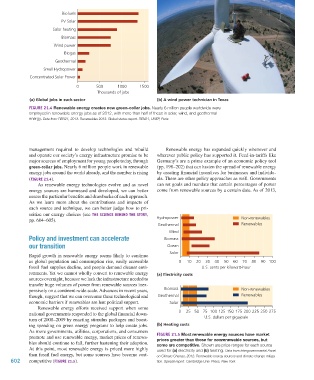Page 603 - Environment: The Science Behind the Stories
P. 603
Biofuels
PV Solar
Solar heating
Biomass
Wind power
Biogas
Geothermal
Small Hydropower
Concentrated Solar Power
0 500 1000 1500
Thousands of jobs
(a) Global jobs in each sector (b) A wind power technician in Texas
Figure 21.4 Renewable energy creates new green-collar jobs. Nearly 6 million people worldwide were
employed in renewable energy jobs as of 2012, with more than half of these in solar, wind, and geothermal
energy. Data from REN21, 2013. Renewables 2013: Global status report. REN21, UNEP, Paris.
management required to develop technologies and rebuild Renewable energy has expanded quickly whenever and
and operate our society’s energy infrastructure promise to be wherever public policy has supported it. Feed-in-tariffs like
major sources of employment for young people today, through Germany’s are a prime example of an economic policy tool
green-collar jobs. Nearly 6 million people work in renewable (pp. 198–202) that can hasten the spread of renewable energy
energy jobs around the world already, and the number is rising by creating financial incentives for businesses and individu-
(Figure 21.4). als. There are other policy approaches as well. Governments
As renewable energy technologies evolve and as novel can set goals and mandate that certain percentages of power
energy sources are harnessed and developed, we can better come from renewable sources by a certain date. As of 2013,
assess the particular benefits and drawbacks of each approach.
As we learn more about the contributions and impacts of
each source and technique, we can better judge how to pri-
oritize our energy choices (see THe SCieNCe BeHiND THe STOrY,
pp. 604–605). Hydropower Non-renewables
Geothermal Renewables
Wind
Policy and investment can accelerate Biomass
our transition Ocean
Solar
Rapid growth in renewable energy seems likely to continue
as global population and consumption rise, easily accessible 0 10 20 30 40 50 60 70 80 90 100
fossil fuel supplies decline, and people demand cleaner envi- U.S. cents per kilowatt-hour
ronments. Yet we cannot wholly convert to renewable energy (a) Electricity costs
sources overnight, because we lack the infrastructure needed to
transfer huge volumes of power from renewable sources inex-
pensively on a continent-wide scale. Advances in recent years, Biomass Non-renewables
though, suggest that we can overcome these technological and Geothermal Renewables
economic barriers if renewables are lent political support. Solar
Renewable energy efforts received support when some
national governments responded to the global financial down- 0 25 50 75 100 125 150 175 200 225 250 275
turn of 2008–2009 by enacting stimulus packages and boost- U.S. dollars per gigajoule
ing spending on green energy programs to help create jobs. (b) Heating costs
As more governments, utilities, corporations, and consumers Figure 21.5 Most renewable energy sources have market
promote and use renewable energy, market prices of renewa- prices greater than those for nonrenewable sources, but
bles should continue to fall, further hastening their adoption. some are competitive. Shown are price ranges for each source
At this point, most renewable energy is priced more highly used for (a) electricity and (b) heating. Data from Intergovernmental Panel
than fossil fuel energy, but some sources have become cost- on Climate Change, 2012. Renewable energy sources and climate change mitiga-
602 competitive (Figure 21.5). tion. Special report. Cambridge Univ. Press, New York.
M21_WITH7428_05_SE_C21.indd 602 12/12/14 4:29 PM

